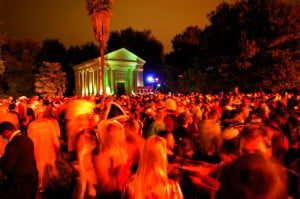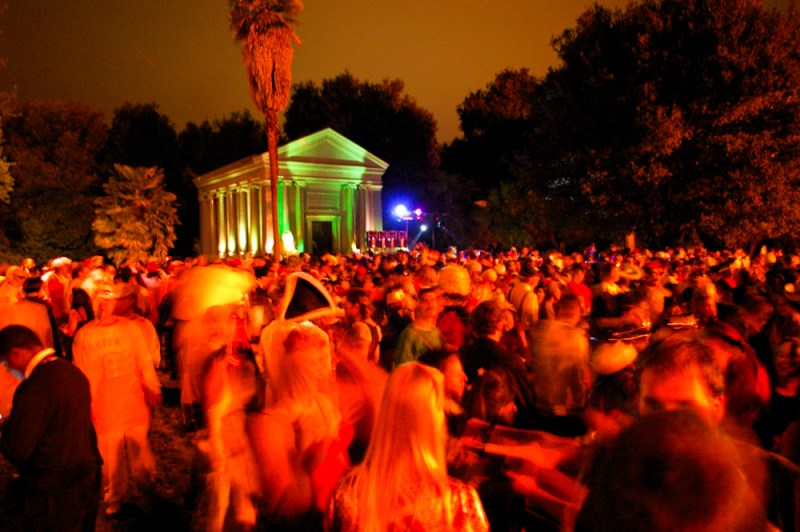Mausoleum attendance was roughly equivalent to the attendance last year despite the lack of a bus service to transport students from dorm areas to the party. Freshmen attendance rose sharply to 72 percent of total Mausoleum attendees, compared to 49 percent last year.
The SUID cards of 1,417 students were scanned at the entrance this year, compared with the 1,477 scanned last year. According to Snehal Naik, assistant dean and associate director of Student Activities and Leadership (SAL), the number of actual attendees varied from the number of scanned IDs by 100 to 200 students.

Buses axed
The junior class presidents decided to cancel buses for “safety reasons,” according to Junior Class President Hunter Kodama ’14.
“We’ve had a number of issues with buses before, more so with overly intoxicated people trying to get on the bus being impatient, getting the bus drivers and other staff like security very frustrated,” Naik said. “The payoff was just not there, [after] analyzing the problems versus the benefits.”
Cost also factored into the decision to cut the bus service. According to Kodoma, the round trip from Tresidder Union to the Mausoleum on a bus takes approximately 30 minutes and a single bus fits 50 riders. Coordination at multiple bus stops also proved difficult last year. In addition to the barricades and security personnel needed at each bus stop, these problems became logistically and financially prohibitive.
After initially deciding to bus students only from the Oval to the Mausoleum, the presidents eliminated buses entirely. They moved the party’s entrance pathway to the intersection of Palm Drive and Campus Drive and added lighting and signage to help students find the Mausoleum.
Kodama and Naik emphasized that student residences are not much further from Mausoleum than they are from Stanford Stadium, where students walk to attend football games.
Kodama attributed the low turnout among upperclassmen to the elimination of the bus system, but noted that he believes attendance will even out in future years because rising classes will not expect buses to be available.
“Ultimately what the decision came down to was the cost effectiveness,” Kodama said. “In order to safely and properly implement a bus system would require many more buses…We decided to instead take some of that money we’d save and put it towards making the event itself better.”
Alcohol concerns
In a presentation on May 18, 2012, representatives from the Office of Alcohol Policy and Education (OAPE) called Full Moon on the Quad (FMOTQ) and Mausoleum “high-risk social events” for alcohol abuse. Alcohol transports were down at both events this year.
Mausoleum had one alcohol transport this year, compared with “five or six” last year, according to Naik. Stanford University Department of Public Safety (SUDPS) Public Information Officer Bill Larson reported no arrest or altercations. According to Larson, Kathy Harris, Stanford Emergency Medical Service (StEMS) supervisor reported only “a handful of small medical issues.”
“The information that went out about the event, about what exactly happens at the mausoleum, is very important…[such as] how the flyer was made specifically mentioning about zero tolerance for intoxication,” Naik said.
Cardinal Nights sponsored Scream on the Green, a movie screening of two Halloween-themed films on Levin Field, simultaneously with Mausoleum. The first screening began at 9 p.m. and, according to Kodama, gave students an “alternative to pre-gaming.” He said that the second screening at 11 p.m. provided a social venue for students “not into the party scene at Mausoleum.”
Kodama also reported positive feedback from resident assistants (RAs) in freshmen dorms regarding the elimination of the buses. RAs were able to advise their residents to remain sober enough to be able to navigate to the Mausoleum and some walked their dorms in groups to the party.
SAL also doubled the number of professional student affairs staff at the event.
“I saw at FMOTQ that staff did better when they were paired up with somebody,” Naik said. In the past, three or four student affairs staff members attended Mausoleum but this year eight attended.
OAPE added a training session for Mausoleum sober monitors. Around 50 student volunteers helped staff the event, a significant portion of whom were not affiliated with the junior class cabinet or the ASSU, according to Kodama.
Mausoleum changes
There were also changes to the physical set-up for the party, including the entry pathway decorations and speaker system set-up.
The pathway from the intersection of Palm and Campus Drives was decorated to emulate a “Halloween funhouse at a fair,” according to Kodama. Stanford Event Services staff members lit the pathway to match the Halloween theme and the junior class presidents arranged for a “scary performer” to frighten students on their way in. A separate speaker system played Halloween-themed music to “set the mood.”
Organizers rented barricades in order to seal off the Mausoleum and ensure attendees used the scanner-equipped entrance. Usually, these barricades are rented from SUDPS but this year they were rented from an outside organization because the SUDPS barricades had already been set up for the Stanford v. Washington State football game the next day.
The cabinet also added a truss above the DJ booth to “improve the look” of the party and a photo booth, which Kodama described as a “huge hit.” Photos from the night are available on the Mausoleum Facebook page.
Naik described the lighting as the best he has seen in five years of working with junior class presidents to plan the event.
Organizers and SAL were also wary of the potential for noise complaints. This year, SUDPS shut down FMOTQ early due to numerous noise complaints from Palo Alto residents. At Mausoleum, SAL supervisors used a decibel reader to monitor the sound level.
“Every time you do an outside event there’s always an awareness that we have as part of the community, as students and residents in the local area,” Naik said. “I think we made a good faith effort to make sure that the sound was reasonable”
There was a smaller sound system on hand to be used in the event of noise complaints, but none were reported.
“Aside from the one transport, I think everything else was fantastic,” Naik said. “The students did a great job, it was really a joint effort of putting together this event and making it a success, from the details of how it looked to the messaging and the publicity.”
